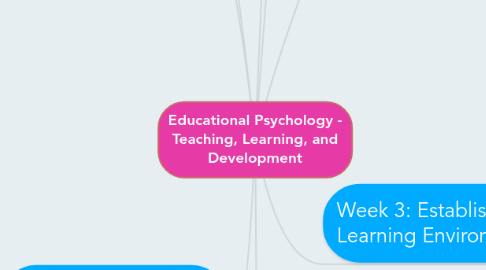
1. Week 5: Assessing Student Progess
1.1. Purposes of Assessment
1.1.1. Universal Design
1.2. Types of Assessment
1.2.1. Diagnostic Assessment
1.2.1.1. Asking questions, informal...
1.2.2. Formative Assessment
1.2.2.1. Observable
1.2.2.2. Homework, quizzes, participation...
1.2.3. Summative Assessment
1.2.3.1. Tests, assignments, presentations...
1.2.3.2. Quantitative
1.3. Assessment Questions
1.3.1. Selected Response Questions
1.3.2. Constructed Response Questions
1.4. Authentic Assessment
1.4.1. Eg. Portfolios
1.5. Assessment Design Process
1.6. Working Memory
1.6.1. Chunking
2. Week 6: Individual Differences
2.1. Intelligence
2.1.1. Structure and Process
2.1.2. Gardner's Theory of Multiple Intelligences
2.1.2.1. 8 Forms
2.1.3. Sternberg's Triarchic Theory of Intelligence
2.1.3.1. 3 Forms
2.1.4. Can intelligence be universally defined?
2.2. Special Education
2.2.1. Inclusion
2.2.2. IPRCs
2.3. Students with Exceptionalities
2.3.1. High-instence Exceptionalities
2.3.1.1. Learning disabilities, mild intellectual disabilities, giftedness, behavioural disorders (ADHD and Austism)
2.3.2. Low-instence Exceptionalities
2.3.2.1. Severe mental/physical disability, hearing or visual impairment
2.4. Cognitive Styles, Learning Styles, and Temperament
2.4.1. Universal Design
2.4.1.1. Differentiated Instruction
2.5. Individualized Education Programs
2.5.1. 6 Phases
2.5.2. Educational Goals
3. Week 7: Socio-cultural Considerations
3.1. Aboriginal Education
3.1.1. Risk factors vs. Stats
3.1.1.1. Lack of Parental Support
3.1.1.2. Lack of Qualified Educators
3.1.2. Community Involvement/Resources
3.1.3. Early Intervention
3.1.4. Family Engagement
3.1.5. Resiliency
3.2. Exploration of Research
3.3. Culturally Responsive Practices
3.3.1. Cultural Identity
3.3.2. Cultural differentiated instruction
3.4. Socio-cultural Perspectives
3.4.1. Values of different cultures
3.5. Stereotype Threat and Socio-Economic Status
3.5.1. Impact on Education
3.5.2. Influence on Parenting Style
3.5.2.1. Potential threat to education or fosters academic growth
3.5.3. Approach to Education
3.5.4. Largest impact on academic success!
3.5.5. Behaviour confirming negative stereotype
3.6. Multicultural Education
4. Week 8: Standardized Achievement Tests
4.1. Purposes
4.1.1. Provincially mandated
4.1.2. Criterion Referenced
4.1.3. EQAO Testing (Grades 3, 6, and 9)
4.1.4. Grade 10 Literacy Test
4.1.5. Accountability
4.2. Outcomes
4.2.1. Student anxiety, nervousness, stress...
4.2.2. Yerkes Dodson's Law
4.2.2.1. Arousal vs. Performance
4.2.3. PROS
4.2.3.1. Comparison tool among schools, provinces, and even countries
4.2.3.2. Accountability
4.2.3.3. Finds strengths and weaknesses within a system
4.2.4. CONS
4.2.4.1. May lead to disengagement in the classroom
4.2.4.2. Solely teaching the test
4.2.4.3. Not able to differentiate
4.2.4.4. Doesn't account for cultural or linguistic differences among students
4.3. Connection Between Classroom Curricula and Standardized Tests
4.4. Student Preparation
4.5. Five Essential Elements
4.6. Meaning
4.6.1. Same amount of time and conditions
4.6.2. Same support, preparation, and tools
4.6.3. Same questions and evaluation
5. Week 1: Planning for the Upcoming School Year
5.1. Schwab's Four Commonplaces
5.1.1. Teacher
5.1.2. Curriculum
5.1.3. Students
5.1.4. Classroom
5.1.5. Having balance between all four commonplaces
5.2. Constructivism
5.2.1. Student-centered
5.2.1.1. Self-regulated Learning
5.2.2. Active construction of knowledge and skills
5.2.3. Inquiry-based activities
5.2.4. Student's constructivism on understandings
5.3. Teacher-centered
5.4. Curriculum Planning
5.4.1. Assessment
5.4.2. 5 W's & How
5.4.3. Materials for Lessons
5.4.4. Methodology
5.4.5. Top-down Approach
5.5. Research
5.5.1. Qualitative vs. Quantitative
5.5.2. 5 Steps
5.6. Metacognition
6. Week 2: Considering Child and Adolescent Development
6.1. Principles of Development
6.1.1. Order and Logic
6.1.2. Gradual Process
6.1.3. Qualitative and Quantitative
6.1.4. Physical, biological, and cognitive
6.2. Growth Mindset
6.2.1. Compared to a fixed mindset
6.2.2. Challenging
6.3. Piaget - Learning Theory
6.3.1. Adaptation
6.3.2. Sensorimotor
6.3.3. Pre-operational, concrete operatonal, and formal operational,
6.3.4. Role of the individual
6.3.5. Schema/schemes
6.3.6. Equilibrium
6.4. Vygotsky
6.4.1. Scaffolding
6.4.1.1. Collaborative Thinking
6.4.2. Zone of proximal development
6.5. Erikson
6.5.1. Psycho-social Development
6.5.1.1. 8 Stages
6.6. Optimal Zone
6.6.1. Yerkes Dodson's Law
6.7. Societal Influences
6.7.1. Ecological Theory
7. Week 3: Establishing a Positive Learning Environment
7.1. Effective Classroom Management
7.1.1. Collaboration
7.2. Dynamic Classroom Management
7.2.1. Proactive
7.2.2. Explicit
7.2.3. Student Management
7.2.4. Input of students
7.2.5. Collaboration
7.3. Classroom Rules
7.4. Behaviour
7.4.1. Motivational Factors
7.4.2. Management Skills
7.5. ADHD
7.5.1. Equity vs. Equality
7.5.2. Accountability
7.5.3. Expectations
7.5.4. Don't punish for behaviours they can't control!
7.6. Discipline, Prevention, and Consequences
7.6.1. Higher engagement = lower misbehaviour
7.7. 3 Fundamental Needs
7.7.1. Autonomy
7.7.2. Competence
7.7.3. Relatedness
7.8. Learning Styles
7.8.1. Differentiation
7.8.2. Self-regulated learning
7.9. Rita Pierson
7.9.1. Every Kid Needs a Champion
7.9.2. Relationships and Connections
7.9.3. "Kids don't learn from people they don't like"
7.9.4. https://www.youtube.com/watch?v=SFnMTHhKdkw&feature=youtu.beT
8. Week 4: Making Instructional Decisions
8.1. Three Guiding Principles
8.1.1. Universal Instructional Design
8.1.1.1. Equity
8.1.1.2. Variety of instructional methods
8.1.1.3. Clear expectations
8.1.2. Teaching is accomplished by explaining or demonstrating
8.1.3. Learning is a high complex function
8.2. Stiggins's Achievement Targets
8.2.1. Knowledge
8.2.2. Reasoning
8.2.3. Skills
8.2.4. Products
8.2.5. Attitudes and Dispositions
8.3. Learning and Assessment Connection
8.4. Learning Goals, Objectives, Lesson Plans
8.4.1. Backward's Design
8.4.2. Bloom's Taxonomy
8.4.2.1. Knowledge
8.4.2.2. Comprehension
8.4.2.3. Application
8.4.2.4. Analysis
8.4.2.5. Synthesis
8.4.2.6. Evaluation
8.4.3. Inquiry
8.5. Cognitive Strategies
8.6. Direct Instruction
8.6.1. Teacher-centered
8.7. Student problem-solving
8.8. Metacognition
8.8.1. Thinking about thinking
8.8.2. Critical thinking
8.8.3. Reflection, planning, gauging, and comprehension
8.9. Different Learning Styles
8.9.1. Differentiation
8.10. Inquiry-based Learning
8.10.1. Curriculum integration
8.10.2. Understanding as common goal
